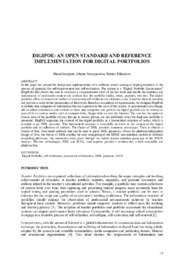| dc.contributor.author | Georgiou, Eleni | en |
| dc.contributor.author | Stassopoulou, Athena | en |
| dc.contributor.author | Dikaiakos, Marios | en |
| dc.coverage.spatial | CY - Λευκωσία | en |
| dc.creator | Georgiou, Eleni | en |
| dc.creator | Stassopoulou, Athena | en |
| dc.creator | Dikaiakos, Marios | en |
| dc.date.accessioned | 2016-02-15T06:20:19Z | |
| dc.date.available | 2016-02-15T06:20:19Z | |
| dc.date.issued | 2003 | |
| dc.identifier.uri | http://hdl.handle.net/10797/14656 | en |
| dc.description | Περιέχει το πλήρες κείμενο | el |
| dc.description.abstract | In this paper we present the design and implementation of a software system aiming at helping educators in the process of appraisal for self-improvement and self-evaluation. The system is a "Digital Portfolio Environment" (DigiPoE) that allows the user to construct a comprehensive view of his/her work and enable the insertion and maintenance of multimedia content and artifacts into the portfolio (audio, video, graphics, text etc). The digital portfolio offers an innovative method of assessment/self-evaluation to educators since it enables them to maintain and provide a much richer presentation of their work. Based on an analysis of requirements, we designed DigiPoE to include nine categories of information that are important to the users of the system. A user/educator can change, add or delete information and artifacts in these nine categories and publish the digital portfolio (in its entirety or parts of it) on various media, such as compact disks, floppy disks or over the Internet. The user has the option to
choose parts of the portfolio (if any) that are to remain private, i.e. not published, when the final user portfolio is presented. DigiPoE organizes the content of the digital portfolio as a hierarchical structure of nodes, which is encoded as an XML grammar. This hierarchical structure is essentially an index to the content of the digital portfolio and its collection of artifacts. The choice of XML provides numerous advantages. There is already a variety of free, Java-based software that can be used to parse XML grammars. Given the platform-independent design of Java, the choice of XML enables the easy retargeting of the DiPoE user-interface module to different computing platforms; this interaction takes place through the widely known interface paradigm of the WWW browser. The two technologies, XML and JAVA, used together provide a solution that is both extensible and platform free. | en |
| dc.language.iso | eng | en |
| dc.publisher | Department of Educational Sciences, University of Cyprus | en |
| dc.relation.ispartof | Computer Science | en |
| dc.rights | info:eu-repo/semantics/openAccess | en |
| dc.rights | Open Access | en |
| dc.source | CBLIS Conference Proceedings 2003 Volume I: New Technologies and their applications in education | en |
| dc.title | Digipoe: an open standard and reference implementation for digital portfolios | en |
| dc.type | info:eu-repo/semantics/conferenceObject | en |
| dc.subject.uncontrolledterm | Self-evaluation | en |
| dc.subject.uncontrolledterm | Assessment of educators | en |
| dc.subject.uncontrolledterm | XML grammar | en |
| dc.subject.uncontrolledterm | JAVA | en |
| dc.subject.uncontrolledterm | Digital Portfolio | en |
| dc.contributor.conferenceorganizer | Learning in Physics Group, University of Cyprus | en |
| dc.contributor.coordinator | Constantinou, Constantinos P. | en |
